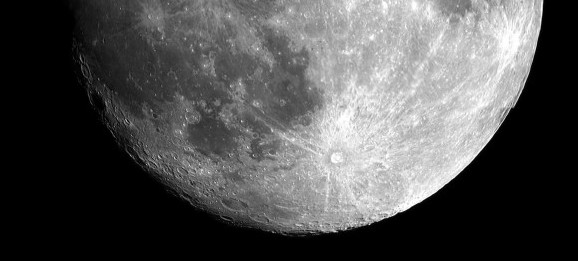
*This post was written before the GLXP released new information about the prize deadline on 16th August 2017 – and is based on the idea that the teams must launch before the end of 2017*
In 2010 I found myself on the Isle of Man, reporting on the Google Lunar XPRIZE team summit that was taking place there. It was one of the first space-themed things that I’d ever been involved with, and as such, I was super excited to hear about a competition where a host of internationally-based teams were racing to send rovers to the Moon.
“Robots on the Moon” I thought, “wow. That. Is. Cool”
Here we are in 2017, the 36 original teams have been whittled down to just five, and the deadline for reaching the Moon, despite having been previously extended twice, is now looming large. To win, teams have to land on the Moon, drive 500 m and send back HD video – by the end of 2017. There are just five months left.
Now in the interests of transparency, I should mention I’m now working with PTScientists, (previously known as the Part-Time Scientists) who were one of original 36 Google lunar XPRIZE teams. They are no longer competing as their launch is scheduled for post-2017, and thus don’t meet the deadline for the GLXP. This post is solely based on publicly available information (as linked in the piece), and I only speak for myself, not my employer. Okay – official-ese done, let’s get down to business…
Space is hard, we know that, and managing a soft-landing on another celestial body adds an additional layer of complexity. That’s before you consider that rovers need to be deployed safely, drive 500 m and send high-quality video back to Earth.
Getting over the first hurdle – launch – is one of the hardest to achieve, and that’s what I’m going to focus on here – since without it, the rest is immaterial. So let’s take a look at the runners and riders, and see whether we’ll see a private mission on the Moon by the end of this year.
SpaceIL
Let’s start with SpaceIL – the Israeli team – since it seems they are now aiming for a 2018 launch, which automatically rules them out. What happened to the launch contract that got them through to the final five? Well, (as one article suggests) they may have sold their launch slot on a SpaceX Falcon9 or (as another article suggests) are suffering from SpaceX launch slippages, and now targeting a 2018 launch. In either of these scenarios, they will not meet the requirements on the Google Lunar XPRIZE. So that leaves us with four.
MY VERDICT: Out of the running
Team Indus
The only team that does have a scheduled launch date is Team Indus, surely making them the favourite at this point. (Other strong teams Astrobotic and PTScientists opted for post-2017 launches and have thus left the competition already.)
We know that India’s national space programme has come on in leaps and bounds over the past few years, and there can be no shortage of smart engineers to form a team there. Add to that they are launching on a proven launch vehicle (the PSLV) and have a scheduled date for launch and things are looking good. That said, a launch date of 28th December 2017 leaves very little room for delays or problems of any kind, since the deadline for launch (thought thankfully for them not landing) is the end of this year. Any launch slip could put them perilously close to disqualification (how cruel if a launch were to be pushed back to 1st January 2018?!).
Another issue is that launches are expensive, and there are some signs that they are struggling to raise the cash required to guarantee their space on the rocket. Then there is this article which suggests that they don’t hold the necessary paperwork required, thus putting the whole mission at risk for other reasons.
MY VERDICT: IF red-tape and finances are in order, they’ll get my vote. But it’s a BIG “if”.
Moon Express
Next up is Moon Express. I regularly hear this team touted as a favourite to win the prize, and I certainly think they are good at pushing their image in the space press, but let’s look a little bit closer at their chances.
Moon Express has a launch contract with New Zealand start-up (with US company listing) Rocket Lab USA, about whom very little information was available until they conducted a recent test launch of their Electron Rocket. Interested to find out a bit more about their chances of getting to the testing phase I looked into whether New Zealand had granted them a licence to launch, and discovered that the framework for them even to apply for such a thing had to be quickly rushed through parliament! New Zealand has not been considering a space-faring nation up until then, so it’s interesting to see things evolve for them.
Anyway, back to Rocket Lab. They conducted a test launch – #itsatest – on 25th May 2017. For all the positive press that this received, one major element seems to have been overlooked: it didn’t make orbit. Now, for a first test of a rocket, that’s not the end of the world – but for Moon Express, who are relying on this vehicle to help them on their journey to the Moon, it’s a Big Deal.
Rocket Lab stated that they were going to run three test launches before taking commercial payloads, unless the earlier launches went particularly well, and they might then consider taking commercial payload on a later test launch. We’re two months since their first launch and they are still crunching the data. It didn’t go brilliantly, so the likelihood that they will take payload on the next test launch is low, and, not to put too fine a point on it, time is running out.
Another side thought is this: I’ve seen pictures of the mock-up of the MX-1E lander and it seems pretty small. I’m not a rocket scientist (sadly), but it sort of feels like maybe they would need more fuel to get to the Moon from Earth orbit, no? Unless they have another launch vehicle lined up, I wouldn’t put my money on Moon Express getting to the Moon this year – no matter how good their media game is.
MY VERDICT: Good patter, but over-optimistic. Without a different launch vehicle, I’m going to take a punt and say it ain’t happening this year.
Synergy Moon
Who are we left with then? There’s Team Synergy Moon, but again, they are relying on a new rocket – and it’s being built by one of their founding partners, Interorbital Systems. According to Synergy Moon, they will launch on a Neptune-8 rocket, so I went to find out a bit more about it. So far, it doesn’t appear to exist, but Interorbital Systems describe the Neptune rocket family as being “assembled from multiple Common Propulsion Modules (CPMs)”. So a bit like Lego bricks then? Just stick a few more modules together for a bigger rocket? Hmmmm.
This is where it starts to get a bit confusing. There is different (and at times contradictory) information online, and even the company website can’t seem to make up its mind! Depending on the section you read, Synergy Moon is either launching on an N8 LUNA rocket, comprised of 8 long CPMs, or an N36 (which, if you follow their naming convention of the small Neptune rockets, would involve 36 propulsion modules!). I found an amazing image, (credited to Interorbital Systems, but apparently no longer on their site) which shows what the N36 might look like. Forgive me for feeling less than confident about this modular approach.
Their latest press release (from 25th July 2017) announces that their N1-GTV is almost ready for a low-altitude flight test. Once this is complete they will attempt to build an orbital version. Given the N1 forms the basis of their larger rockets, they are a long way from getting to the Moon. Oh – and I didn’t mention their plan to launch from “a private island launch site or from the open ocean” did I?
I’m afraid this is rocket science, and there is a reason that that clichéd phrase is often used – it is hard. Once again there is no news of a launch date as far as I can tell, so again, I’m putting their chances at small to miracle.
MY VERDICT: I admire the innovation, but I think they’ve bitten off more than they can chew.
Team Hakuto
That means it’s all down to Japan’s Team Hakuto then, which is a bit of an issue really, since not only do they not have their own landing vehicle (which frankly doesn’t seem in keeping with the spirit of the original competition), but without Team Indus, they won’t have a launch either. Oh.
MY VERDICT: Hitchhiking to the Moon isn’t easy… even if they make it I’d credit Team Indus with the win.
Is anyone capable of winning the Google Lunar XPRIZE this year?
I’d say – no. In fact, I think I’d put money on it. That’s not to say it is impossible, but at this point it is so improbable that I’m frankly surprised that Moon Express are still publicly pushing a message that they think they can win.
I actually got in touch with the GLXP press contact (as listed on their site) recently to find out whether I’d missed any press releases. The most recent one about the status of the GLXP, which they kindly pointed me to, was that from January, when they announced the five teams through to the final stage. The fact that there didn’t seem to be any launch scheduling updates – with so little time left in the competition – should ring alarm bells, even if nothing else I’ve written, has.
Is the GLXP a failure?
While it is of course disappointing that it is nigh on impossible for any team to meet the requirements of the challenge as it currently stands, the very fact that there were so many teams that came together to give it a shot is a brilliant thing. (And of course, if any of the remaining teams were to prove me wrong, I’d be the first to celebrate their success!)
At least three of the original teams have developed serious business plans that expand on the basic GLXP requirements (to land, drive 500 m and send back HD video). Moon Express recently announced a range of vehicles that they hope to use to expand their Moon business, PTScientists will conduct a range of scientific experiments and technology demonstrations on the lunar surface – as well as returning to the site of Apollo 17 to investigate the structure of the original Lunar Roving Vehicle after 45 years on the Moon, and Astrobotic have a partnership with DHL to allow you to send a keepsake to the Moon using a DHL MoonBox. All three companies are banking on a demand for payload delivery services to the Moon (– and beyond?).
Without the GLXP I doubt there would have been the impetus for these companies to be founded and to invest in developing new technology. Despite all the talk about Mars in the past few years, I have noticed a serious and growing interest in the Moon. This year will see China’s Chang’e 5 sample return mission launch to the Moon, ESA Director General Jan Woerner is pushing his “Moon Village” agenda, and at the recent Global Space Exploration Conference there was a real buzz around discussions involving the Moon.
I think that this is a trend that is set to continue, and Google Lunar XPRIZE-inspired teams have a great opportunity to lead the charge in the private sector – becoming valuable and accessible partners for space agencies, nations and industry.
Whether or not any team manages to fulfil the GLXP challenge before the deadline (which I greatly doubt), there is no question in my mind that the Google lunar XPRIZE has been a force for good.
I will be watching the remaining teams – and those companies that opted for later launch dates – with interest. Cheers Google, and cheers XPRIZE. Here’s to the Moon! Ad astra et ad luna!
UPDATE: It appears that XPRIZE may have come to the same conclusion about the 2017 deadline. Their latest press release gives teams until 31st March 2018 to complete their missions, while elsewhere on the site it states that the teams’ verified launch dates are in 2018. Interesting…

Opinion by .
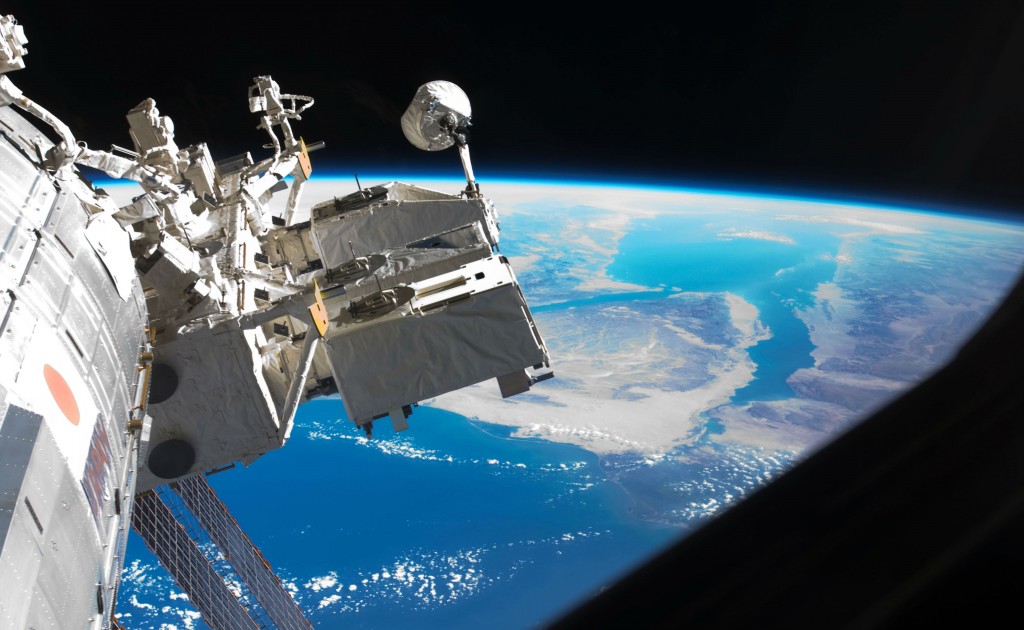
Japanese astronaut Soichi Noguchi may have made the mainstream media with his photos from the international space station some years ago, but ask the average person in the street to name the big players in space, and I’m willing to bet that Japan wouldn’t be at the top of their list.
Us space geeks on the other hand may know a bit more about their space activity. Perhaps it’s a fondness for the Japanese Kibo module on the ISS, an ability to name several of their astronauts (Koichi Wakata, Chiaki Mukai, Soichi Noguchi etc), awareness of the H-IIB ISS resupply rocket, or excitement about their asteroid sample return mission Hayabusa2.
But did you know that Japan has quietly been running a programme to promote space activity in countries that have previously had none? I didn’t. Well, not until a recent request to talk about Ghana’s first satellite – GhanaSat-1 – on BBC World Service programme Click Radio. I knew that CubeSats have been launched from the ISS and indeed, from the Kibo module, but this was the first time I had put some effort into researching them further.
Japan’s “Birds”
I’m pretty excited about what I found out, and I don’t recall reading much (if anything) about Japan’s “Birds” programme, so I thought I would write something myself.
The “Birds Project” is a cross-border interdisciplinary satellite project for non-space-faring nations that is run by the Kyushu Institute of Technology and supported by Japan. Birds-1 saw five nations each develop and operate a 1 kg CubeSat (10 x 10 x 10 cm), which was then delivered to the ISS on a SpaceX Dragon capsule in June 2017, and deployed on 7th July 2017.
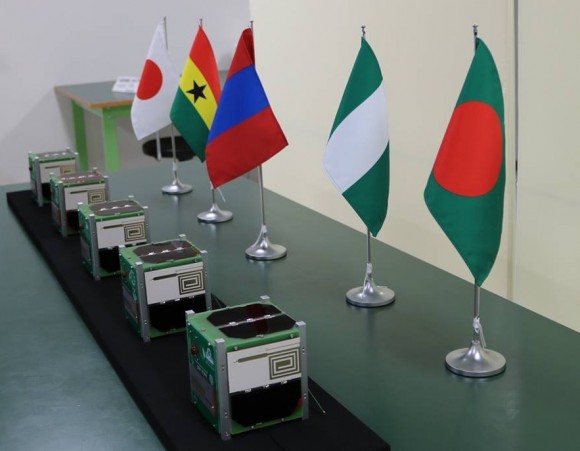
Birds-1 CubeSats by their respective nations’ flags. Credit: Birds Project
For Ghana, Mongolia and Bangladesh, this marked their first foray into space – a fact celebrated by the president of Ghana, Nana Addo Dankwa Adufo-Addo . Nigeria and Japan were the other countries involved with building satellites, and Thailand and Taiwan built ground stations to support the mission.
Launching from the ISS
It was a project of firsts: the satellites were delivered on SpaceX’s CRS-11 mission, the first time a re-used Dragon capsule has revisited the ISS (having been used on CRS-4 in 2014), it was the first space mission for Ghana, Mongolia and Bangladesh, and formed the first five CubeSat network with seven ground stations.
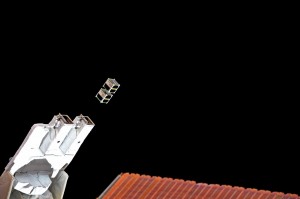
Deploying the Birds-1 cubesats from the ISS Credit: NASA/Jack Fischer
The CubeSats were deployed from J-SSOD – the JEM small satellite orbital deployer (JEM being the Japanese Experiment Module – a.k.a. Kibo). The CubeSats are delivered to the ISS ready-packed into satellite install cases, and astronauts onboard the station fix these to the multi-purpose experimentation platform (MPEP) pass through the airlock on a special slide table to the exterior of the space station. From there, the Japanese Remote Manipulator System (robotic arm) picks up the MPEP and moves it into the correct site for satellite release.
Another great example of International Cooperation today on @Space_Station –launched 5 micro-satellites from 5 countries off the JAXA arm! pic.twitter.com/w0pcvPJ64y
— Jack Fischer (@Astro2fish) July 7, 2017
When launching CubeSats from the space station, you must be sure that you launch them into an orbit that will not clash with your own – else you could risk colliding with them, which would be at best, unfortunate, and at worst costs the lives of the station crew and perhaps the station itself!
The orbit of CubeSats launched from the ISS depends on the station’s altitude at release, and the ballistic force that they are launched with. They go into an elliptical orbit of an altitude of between 380-420 km and their life expectancy (before the orbit deteriorates and they burn up in Earth’s atmosphere) is anything between 100 to 250 days.
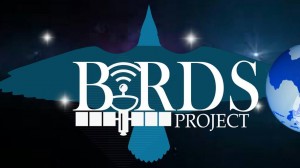 Birds-2 is already well underway, and successful launch of CubeSats from that mission will enable Bhutan, Malaysia and the Philippines to join the list of space-faring nations.
Birds-2 is already well underway, and successful launch of CubeSats from that mission will enable Bhutan, Malaysia and the Philippines to join the list of space-faring nations.
So why is this important? Or exciting?
Space is a brilliant source of inspiration and opportunity for new research and data that has a real tangible benefit to people on the ground, but it is costly. For nations that do not already have the infrastructure required to take part in space activities, the barrier to entry due to costs and technical expertise can be too high. This is especially true for countries that may still be thought of as “developing countries” in an Earthly sense, and yet they may stand to gain enormously from Earth-observation data that can be collected from space.
BRAC Onnesha – the Bangladeshi CubeSat – will take high resolution images to analyse vegetation, urbanisation, floods, forestry and water availability. GhanaSat-1 has high- and low-resolution cameras and will be used to monitor their coastline, as well as testing the effect of space radiation on commercially available microprocessors. They’re also going to play the Ghanaian national anthem and songs of independence in space!
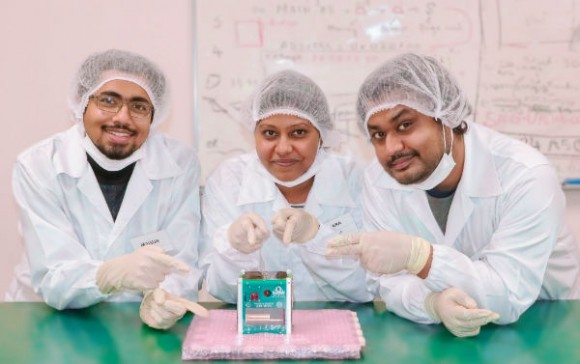
The team behind the Bangladesh’s first satellite, BRAC Onnesha Credit: BRAC Onnesha
Importantly, this is an issue of inclusivity. Space belongs to no single nation, and access to it should not be limited to those nations lucky enough to have a historic national space programme, or enough cash to build one. Space exploration is increasingly considered an international endeavour, and it is important to me that we involve as many nations as possible. Those countries with expertise and facilities should offer a helping hand to those without access to the same opportunities as them. In the end, the more minds and perspectives we have working to solve the problems of long duration space travel, the better.
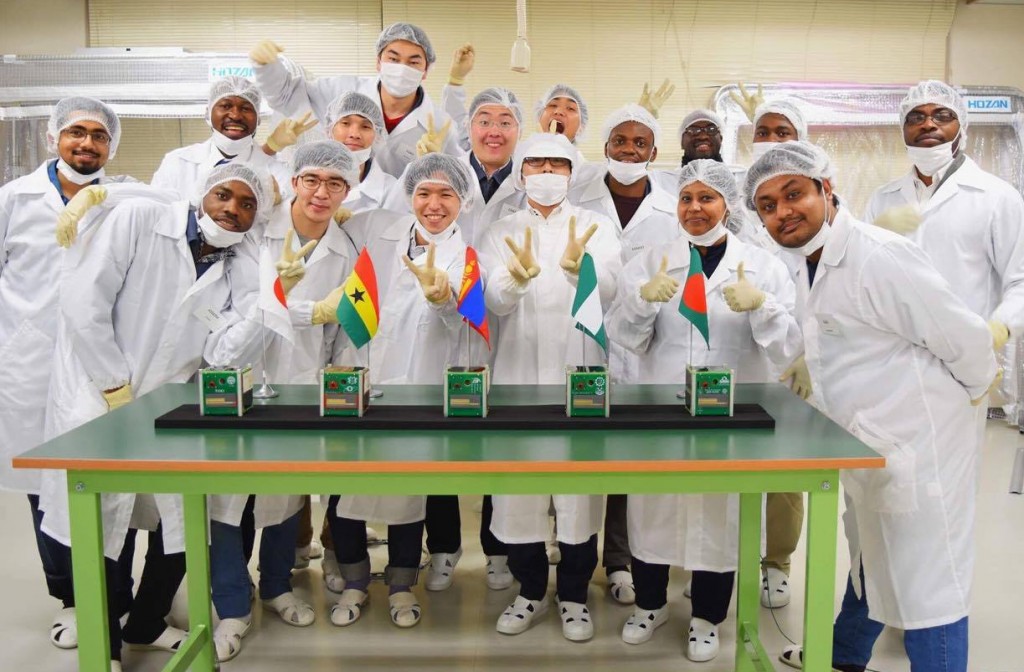
Congratulations to the whole Birds-1 Project Team for their successfully satellite deployments!
Bravo to Japan for opening these opportunities for non-spacefaring nations – and here’s hoping that the teams’ success will spark a bigger interest in space in their home countries. The ability for space research to transcend national borders and politics is something that makes it special – let’s not leave anyone behind.
Did you know? Journalism News by .
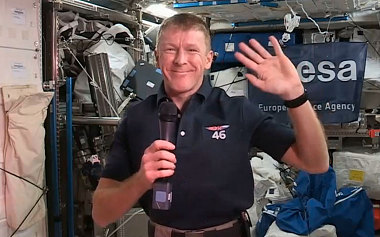
As Britain gets ready to welcome astronaut Tim Peake home from space, I can’t help be distracted by the heartbreaking news about MP Jo Cox, and frankly terrifying new EUref campaign poster from UKIP.
Mine is a blog about space, not about politics, but this is important to me – vitally important. Jo Cox’s life and actions, as well as these words, have inspired me to speak out.
Major Tim Peake is a European astronaut of British descent. He is a European Space Agency (ESA) astronaut. His selection to the ESA astronaut corps came before the UK Space Agency even existed.
 It is correct that Tim is the first non-commercially-funded Brit in space, but none of that would have been possible if it weren’t for the European Space Agency, and the co-operation that comes from the member states.
It is correct that Tim is the first non-commercially-funded Brit in space, but none of that would have been possible if it weren’t for the European Space Agency, and the co-operation that comes from the member states.
No, ESA is not the same as the EU. Yes, we do pay subscriptions to be a member.
But we get money back, on a system of “juste retour”, whereby money paid into the European Space Agency is then invested back into the member states on a proportional basis.
There are certain aspects of ESA that every member country must contribute to, and then there are the “optional” programmes. Things like – you’ve guessed it – human spaceflight.
At the time that Tim Peake was picked in 2009, the UK did not put any money into human spaceflight at all. In fact it rankled a few nations that he was even picked for the astronaut class of 2009 because it meant that countries who were paying in to the human spaceflight stream were paying for the training of citizen of a country who put nothing into that pot. But Tim Peake was an excellent candidate. By all accounts I’ve heard – including from those on the selection committee – he was such a stand out candidate it didn’t matter that the UK wasn’t paying for his training, he earned his place.
Since then, the UK has dipped its toe into programmes such as ELIPS (the European Programme for Life and Physical Sciences) – allowing British scientists access to ESA’s microgravity research platforms, including the space station. This have been a huge boost to scientists working on space biomedicine in the UK. In 2012 we finally committed some money to the human spaceflight budgets also.
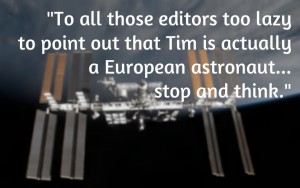
Did we cover the cost of training and then flying Tim to the space station with these investments? No. But, thanks to the co-operative nature of the European Space Agency, we were able to benefit from investments and resources from other countries.
During the EU referendum campaign there has been a lot of talk about protecting “Great” Britain and our achievements, how we would be better off out of the EU, but much less about how working together, and co-operating with other EU nations can also be a really great thing. Greater than the sum of its parts even.
So to all those people claiming Tim Peake for Britain, to all those editors too lazy to point out that he is actually a European astronaut, or even mention ESA, I ask you to stop and think, and reflect the fact that without the European Space Agency, you wouldn’t have a story to write at all.
Don’t pretend that we did this on our own. It’s a lie. Don’t just feed into the idea that we don’t need strong relationships with Europe, or that Britain will be magically better on its own, out of the EU. Remember that co-operation is sometimes the only way that we can achieve great things – like getting to Mars. No one nation could do that alone, and no one nation sent Tim Peake to space. It was a joint effort, and I’m tired of having to point that out to people.
There are big problems in the UK, huge shortages of housing, underfunding of schools and the NHS, pressure on our resources, but to blame all that on the EU, without taking a closer look at the way our country is run, is short-sighted, and dangerous.
Generation Z has a much more global perspective, and yet they are the ones who could inherit a nation that has cut its ties with its closest neighbours thanks to the EU referendum.
Look up to space, spot the international space station and think of the way Russian, American, European, Japanese and Canadian astronauts all work together, to keep each other safe and make progress. Of course it’s not always easy to co-ordinate multiple nations, but by standing together we can do so much more. So before you revel in the great achievements of Great Britain and “our” Tim Peake, remember that without our European and global partners, Britain wouldn’t have even got off the ground.
Opinion by .
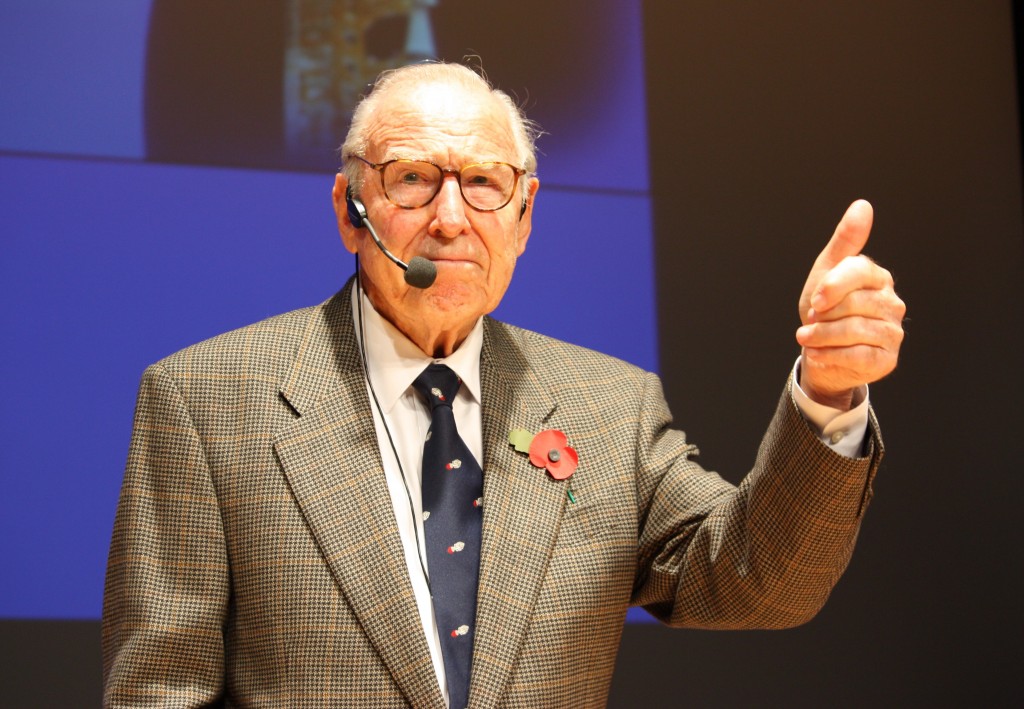
Captain James “Jim” Lovell, a veteran of four space flights, was part the Apollo crew that flew closer to the Sun than any other, and also holds the unfortunate accolade of being the only person to fly to the Moon twice and never step foot on it.
At 87, he’s starting to look a little frail, but that doesn’t stop him holding court for over an hour in a room packed with space enthusiasts. I’m back in Pontefract for the latest in the incredible series of Space Lectures and I, like the rest of the audience, am totally captivated by Captain Lovell.
“There are three types of people in the world”, says Lovell. “Those who make things happen, those who watch things happen, and those who wonder ‘what happened?”. Lovell certainly has had a life filled with adventure, so I’d have to conclude he fits squarely in the former group.
Lovell took part in the first astronaut selection process in 1958, making it down to the last 32, but he lost out to John Glenn, Wally Schirra and the other five guys who went on to become known as the Mercury 7. “I don’t know why” he says, with a glint in his eye.
When the second astronaut selection process took place – this time for the Gemini programme – he applied again.
“By gosh I was selected” says Lovell, with a hint of excitement still present in his voice. “It was the golden age of our space activities” he says, “the whole population was excited about space”.
Gemini 7
 Lovell flew on Gemini 7, which he describes as a medical flight. At that point there was still a lot to be learnt about how the body would survive in space. “Some of the doctors didn’t think we could live in zero-gravity” he says. “We evolved in a gravity-based environment, perhaps we needed gravity for breathing and swallowing?”
Lovell flew on Gemini 7, which he describes as a medical flight. At that point there was still a lot to be learnt about how the body would survive in space. “Some of the doctors didn’t think we could live in zero-gravity” he says. “We evolved in a gravity-based environment, perhaps we needed gravity for breathing and swallowing?”
NASA calculated that maximum time it would take to get to the Moon and back and based the length of the Gemini 7 flight on that to test the body’s reaction to space. At just a fraction less than two weeks in duration, Gemini 7 was the longest of the Gemini missions. The flight had 23 experiments on board “and it was really bad news!” says Lovell, reminding us that the size of the craft is “smaller than a VW”.
“We were guinea pigs” says Lovell, explaining they wore EEGs on their heads, heart rate monitors, and blood pressure cuffs on their thighs – which “blew up for two minutes, then off for six minutes, then again for two minutes.. we were there two weeks!”
One of the experiments was to look at the change in calcium level in the body, and whether that changed when they were in space. You need calcium to keep your bones strong on Earth, but what about in microgravity where your bones are not subjected to the same force? Would the calcium just “flow off”?
For two weeks before their flight everything about them was monitored, how much they ate, drank, and even how much they perspired. The team knew exactly what food they were eating in space and then measured everything for 10 days after the flight while they were in isolation in order to see if there was any change in their calcium levels.
The experiment sounds arduous, to say the least, and Lovell wryly announces “Ladies and gentlemen – I can tell you that a two week mission is not the right length of time to do a calcium balance study”. He’s right of course, and studies on calcium balance in space continue to this day, with Scott Kelly and Mikhail Kornienko currently on the space station carrying out a year-long mission.
There were important things learnt on their mission. Muscles become weak and microgravity has an effect on blood flow and the heart. “Our heart rate was 10 beats per minute slower, and the volume of blood decreased” says Lovell. First the crew was told that they should drink more water, but actually you don’t need quite so much blood in space, since it doesn’t pool down in your feet and legs like it does on Earth.
Gemini 12
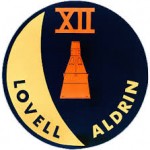 “My second flight was kinda different” says Lovell, talking about Gemini 12, the final mission of the Gemini programme.
“My second flight was kinda different” says Lovell, talking about Gemini 12, the final mission of the Gemini programme.
On Gemini 4, Ed White did the first US spacewalk, he went out attached to oxygen supply, and he floated. On Gemini 9, 10, and 11, NASA tried to get astronauts to do work while on a spacewalk.
“They all failed” says Lovell, “their bodies became overworked”. “We had forgotten the third law of motion, for every action there is an equal and opposite reaction”. Each time they touched the spacecraft it would react, and that was causing problems.
Some “brilliant engineers” came up with the idea for the neutral buoyancy lab – or in those days, a swimming pool with a mock-up space module in the water so they could practice spacewalks. Lovell recalls crewmate Buzz Aldrin in a spacesuit in the pool being reminded “don’t swim” – because in space that would of course be impossible. This allowed them to plan the foot and hand holds on the craft, and “it worked quite well” says Lovell. Gemini 12 was the first mission to show that extravehicular activity was feasible. Nowadays training in huge pools is a standard part of training for astronauts.
Apollo 8
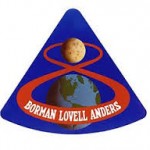 Lovell’s third flight, Apollo 8, was never meant to fly to the Moon, but “1968 changed it completely”. The US received information that Russia was going to fly a crew around the Moon in the autumn of 1968, but they had several failures during the Zond programme. “The re-entry wasn’t right” says Lovell, referring to Zond 4. The Russians successfully sent Zond 5 around the Moon in September 1968 with a crew of tortoises, flies, worms and plants, but there were still some concerns and this led to many arguments back and forth around the safety of a crewed mission.
Lovell’s third flight, Apollo 8, was never meant to fly to the Moon, but “1968 changed it completely”. The US received information that Russia was going to fly a crew around the Moon in the autumn of 1968, but they had several failures during the Zond programme. “The re-entry wasn’t right” says Lovell, referring to Zond 4. The Russians successfully sent Zond 5 around the Moon in September 1968 with a crew of tortoises, flies, worms and plants, but there were still some concerns and this led to many arguments back and forth around the safety of a crewed mission.
During this time, things were progressing in the US, though not entirely as planned. Grumman, who were building the Lunar Module (LM) announced that they “can’t make and deliver the LM in 1968”. This caused a bit of an issue for Apollo 8, which was slated to test the LM in Earth orbit, and take the Command Module (CM) to a high altitude so that they could reach Moon-return speeds and test the heat shield on the CM.
“Without the lunar module, what should we do?” asks Lovell. It was decided that if Apollo 7 tested the CM and it was a successful test, Apollo 8 would be changed so that it would go all the way to the Moon, circumnavigate it, and come back.
It was in summer 1968 that they got word that the mission had changed, and they were scheduled for launch in December the same year. “I spent many a day at MIT learning new guidance systems to navigate to the Moon” says Lovell.
“1968 was kinda a bad year, especially in the US” says Lovell, “there was Vietnam, riots, assassinations” so it was an important mission in terms of morale.
Apollo 8 launched on December 21st 1968, “the navigation was successful, and we saw the ancient old craters on the far side of the Moon” says Lovell. “We were like three school kids looking through a candy store window.”
“We were looking for landing sites on the nearside of the Moon” explains Lovell. “We saw this Earth come up from the lunar horizon – really a fantastic sight – the whites and blues of the Earth, the tan of the deserts”.
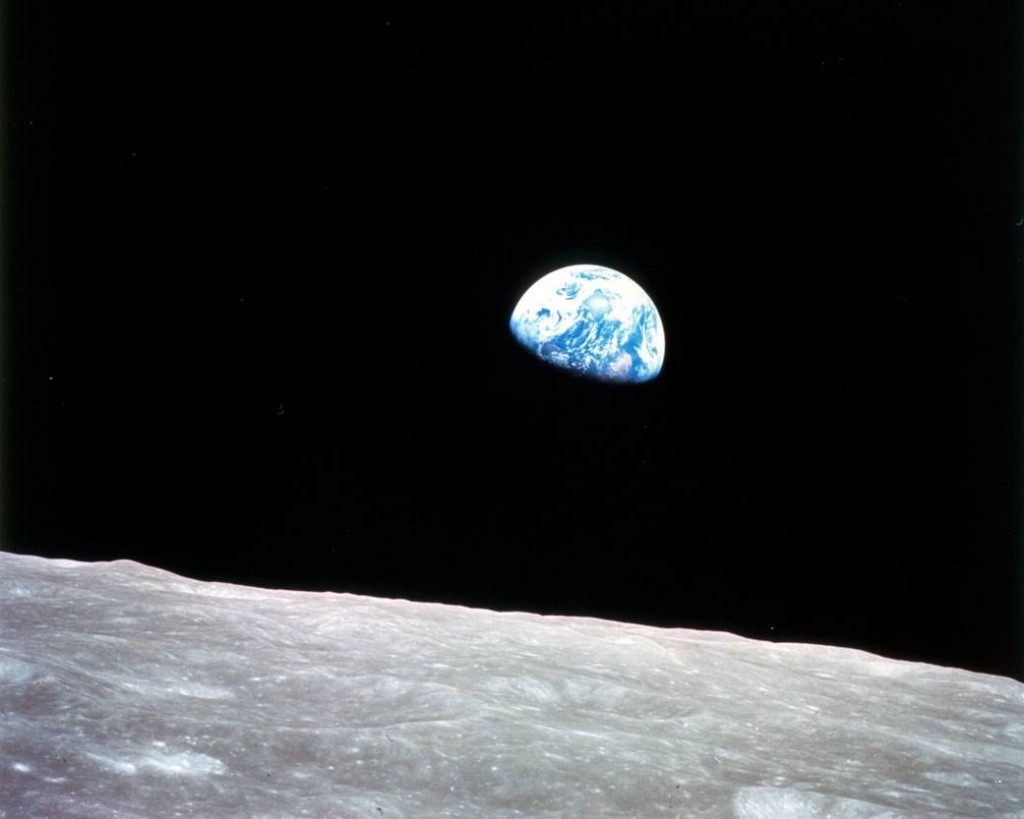
Credit: NASA
The resulting photograph – famously known as “Earth-rise” – springs to instantly to mind, but here is someone remembering seeing that sight for real.
“Earth” he says “just 240,000 miles away, looked totally uninhabited, just tucked away by a normal star, tucked in a normal galaxy”.
“How fortunate we are that we have this place to live” he says wistfully. “People often say when you die you go to heaven, but ladies and gentlemen, you go to heaven when you’re born – this is the place that is really heaven.”
Lovell says that Apollo 8 is the most significant flight of his career, and since he was commander of the drama-filled Apollo 13 mission, I’m quite surprised to hear that.
Apollo 13
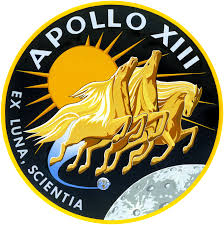 “Apollo 13 was a flight that was plagued by bad omens from the beginning” he begins. “Years before we flew, the company producing the oxygen tanks dropped one on the floor, it was refurbished and it should have been fine”.
“Apollo 13 was a flight that was plagued by bad omens from the beginning” he begins. “Years before we flew, the company producing the oxygen tanks dropped one on the floor, it was refurbished and it should have been fine”.
That fateful tank wasn’t even meant to be used on Apollo 13, it was meant for Apollo 10, but it got switched. Jim Lovell himself was switched from Apollo 14, it was Alan Shepard who was due to fly on Apollo 13. Agreeing to the swap just six months before the flight, his wife was less than impressed with the decision, saying “you did what?! Don’t you know about 13?” How those words must have haunted her…
The crew did a countdown demo test, with the big booster, all consumables, but no fuel. Everything was timed down to zero to check all the systems worked. The test was perfect – “no problems” – but after the test, as the ground crew tried to remove the oxygen tanks, one tank wouldn’t come off. It was that tank, the one that had been dropped all those years earlier.
Inside the tank there was a little heater that was used to burn a little of the oxygen off, the ground crew decided that they could save a bit of time by leaving the tank where it was and burning off the oxygen using the heater. One problem, in flight power for the rocket systems was 28V direct current, while the ground power was 65V DC.
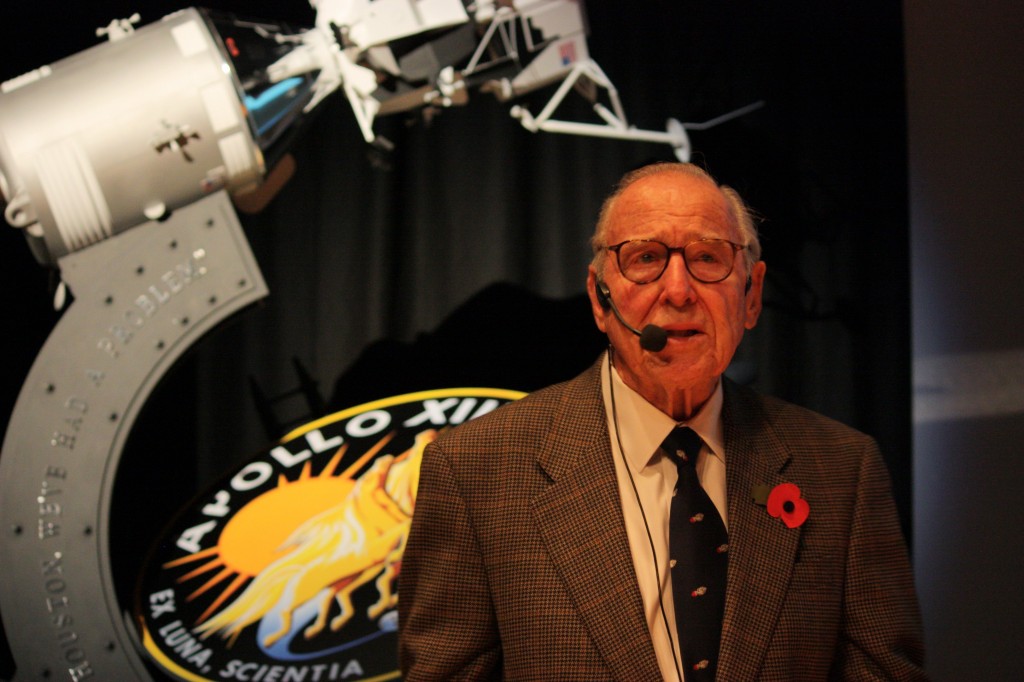
This high voltage welded the contacts from the thermostat together, meaning that instead of shutting off the heater when the temperature was too high, it was actually able to heat the inside of the tank to around 900 degrees Fahrenheit, melting the Teflon inside. The result was that on launch day, when they filled this tank with oxygen, “it was a bomb waiting to go off”.
That wasn’t the only piece of bad luck. The crew were exposed to measles, and while the others were okay, Ken Mattingley, a bachelor, was not immune. He was dropped from the crew and replaced by Jack Swigert.
“It sort of felt like a bad omen coming true” says Lovell, “but we had a good guy with Jack”.
So we get to launch-time for Apollo 13 – 13:13 CST on April 11th 1970. The first stage was perfect, and was jettisoned fine, and then the central engine in the second stage shut down. It was a good job as Lovell says, “if not it would have disintegrated and taken the other four”.
The crew orbited Earth and everything seemed okay, so they set off a free return course to the Moon – whereby you “coast” at 24,000mph all the way to the Moon and then the Moon’s gravity helps to swing you back for a safe return to Earth. All the Apollo missions, from 8-17 started on a free return trajectory.
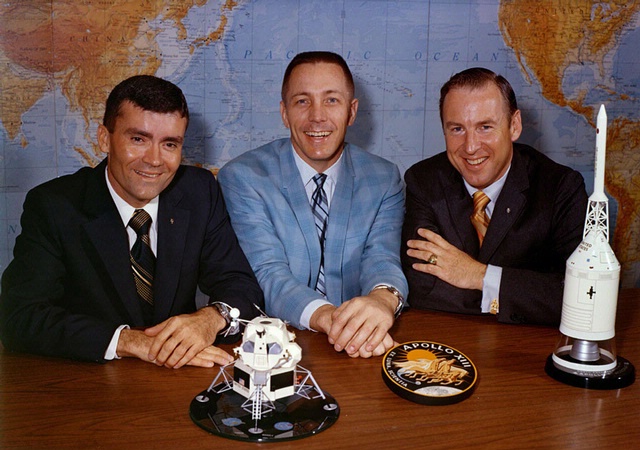
Apollo 13 crew – Fred W. Haise, Jr., John L. Swigert, Jr. and James A. Lovell, Jr.
Mission control came through on the radio to let them know that if they wanted to land at Fra Mauro they need to change the attitude of the spacecraft slightly. This now meant that if an engine failed, their course would take them to the Moon, they’d go round and come back to Earth, but they would be 40,000 miles away – too far to be caught be Earth’s gravity.
On April 13th (of course!) the now famous explosion occurred. Once again Lovell was faced with a change to his mission, except this time the change was “from landing to survival”.
The crew wondered if they had been hit by a meteor and set about trying to close a hatch so that they could maintain pressure in their part of the craft at least. Jack Swigert tried several times but couldn’t manage it, neither could Lovell “so we put it on the catch and tied it down” he says.
“We realised that we weren’t dead yet, so it wasn’t a meteor” says Lovell, deadpan. Out of the window he could see a substance leaking out. “It dawned on me that we were losing oxygen” he says, “the gauge on one tank was at zero, and the needle on the other was coming down”.
“I knew the only way to come home would be to use the lunar module as a lifeboat” he says.
Mission control couldn’t – indeed didn’t – believe it at first, after all, there are so many back-ups in place.
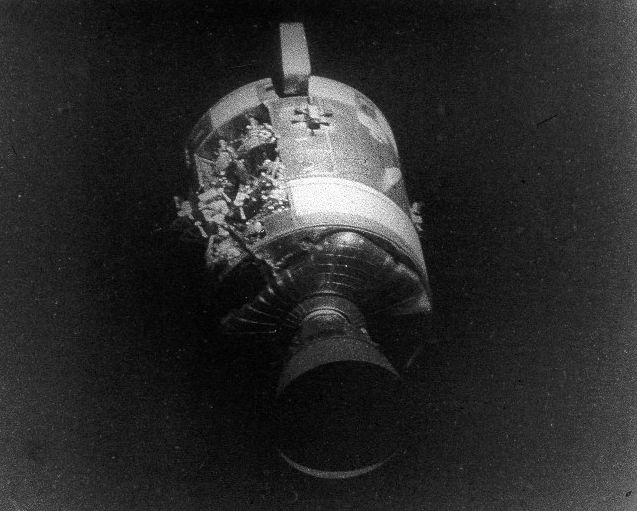
Apollo 13′s damaged service module. Credit: NASA
They lost telemetry, then radio for a while, then mission control decided “you know what this is? It’s a comms problem”. Perhaps it was a solar flare they thought, that’s probably the only problem, “but we knew what had happened” says Lovell.
“The LM is a very fragile device” says Lovell, “the material is so thin you could punch a hole through if you wanted too, and it was designed to last for 45 hours, with two people”.
“After the explosion, I kept counting the crew” he says, “one, two, three”.
“How do we get home?”
The first thing the ground came up with was to get them back on a free return course so that they would “somehow intercept Earth”. Still, that sounded better than skimming round the Earth at 40,000 miles altitude, returning to the Moon, and going round and round, he says.
“Is the command module dead?” they asked. “Yes” replied Lovell. “Well you can use the lunar module as a lifeboat”. “Yes I’ve already thought about that” said Lovell.
Using the attitude control system (ACS) on the lunar module they tried to change the spacecraft’s attitude, but it was never designed or tested to work when still connected to the command and service module. This added 60,000lbs of dead mass that wouldn’t normally be fighting against the ACS on the LM. The centre of gravity was in the wrong place and that caused problems, but the apparently unflappable Lovell merely comments that “you’d be surprised, how quickly you learn when you’re in trouble”.
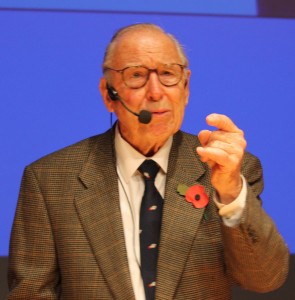 The next crucial manoeuvre involved blasting the engine while they were on the far side of the Moon in order to speed up their return time. But there would be no communication connection with mission control from behind the Moon, so it was incredibly important that they noted the instructions and timings down correctly before they lost contact.
The next crucial manoeuvre involved blasting the engine while they were on the far side of the Moon in order to speed up their return time. But there would be no communication connection with mission control from behind the Moon, so it was incredibly important that they noted the instructions and timings down correctly before they lost contact.
Lovell, as Commander, asked for the rest of the crew to listen for instructions too, to make triply sure they took them down correctly. “Are you ready to copy?” said mission control, and Lovell realised that his two companions weren’t even listening.
“They were looking at the Moon, with cameras, taking photographs”. When he chastised them they said “well, you’ve been here before!”
“They were so interested in the far side of the Moon that they forgot we were in trouble” says Lovell. “I reminded them, if we don’t get home, you won’t get your films developed!” somehow still able to make light of their situation.
They switched on the engine for four minutes, and then “we switched off the ‘exotic’ systems that you can do without” says Lovell, listing off guidance computer and autopilot among them.
“We were left with only the radio, and a fan to keep air circulating” he says. “Things were kinda quiet”.
“When it’s quiet and you’re in a tight spot, you start to think” says Lovell. Swigert worried that they might exceed escape velocity, and Lovell reminded him they were back on the free return trajectory.
“Don’t worry, we have it made” he remembers saying, “but I was wrong”.
Returning to Earth from the Moon is a tricky business, you have to return at a specific angle, no less than 5.5 degrees, no more than 7.5 degrees. “If you come in too shallow, you skim off, too sharp, and you’ll burn up”.
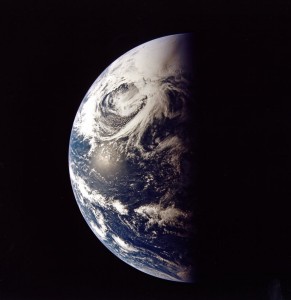
Earth as seen from Apollo 13. Credit: NASA
As it turned out, they were now set to miss Earth not by the original 40,000 miles they were worrying about, but by 60,000 miles. Something had to be done, and without the help of those “exotic” systems they’d been forced to switch off to preserve power.
In an unusual piece of good fortune for Apollo 13, there was one emergency manoeuvre, tested on Apollo 8, that could help them – and as luck would have it, it was actually Jim Lovell who had helped to develop it. The procedure involved getting Earth in the window of the LM, and using the Earth’s terminator (the line when day and night meet), as a navigational aid, allowing them to fire the engine and change course, as famously (though somewhat overdramatically) depicted in the film ‘Apollo 13’.
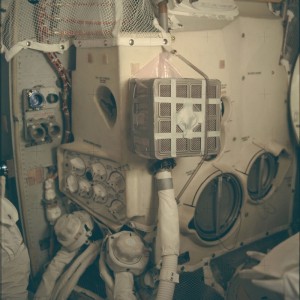
Apollo 13 Lithium Hydroxide Canisters. Credit: NASA
More accurate was the portrayal of the issue of the crew being poisoned by the carbon dioxide in their own exhalation. The CO2 scrubbers in the LM were round, but in the control and service module they were square, and since you (in this case literally) can’t put a square peg in a round hole, a team on the ground worked hard to find a way of converting one into the other, using filters, duct tape and other bits of kit available to the crew in order make it work. They sent up these instructions and the crew was able to solve the problem.
There were still concerns about landing. Had the heatshield been damaged? Would the pyrotechnics deploy the parachutes after having been so cold? Thankfully the the crew splashed down safely, ready to be picked up by the aircraft carrier US Iwo Jima.
Once onboard they radioed back to Johnson Space Center in Houston – “they were happy, but probably ripped up all the obituaries they wrote for us” says Lovell.
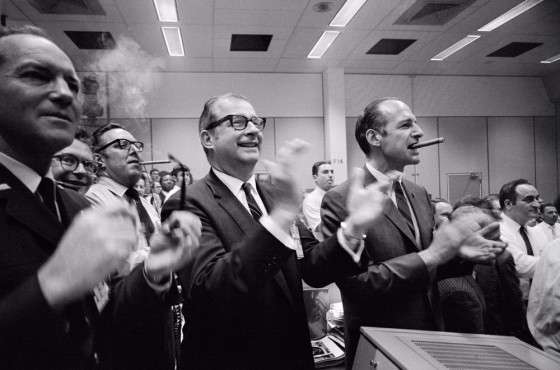
Dr. Thomas Paine (center of frame) and other NASA staff members applaud the successful splashdown of the Apollo 13 mission.
Apollo 13 had made headlines around the world, with millions of people praying for the crew’s safe return, and 55 countries offering water rescue assistance. “Even Paraguay and Czechoslovakia offered their help” says Lovell, “and they don’t even have coastlines!”
For years Lovell was frustrated and disappointed not to have stepped foot on the Moon, but now he’s had a change of perspective. “Apollo 13 brought out what we could do in a crisis” he says.
He explains how he often wonders what would have happened if Apollo 13 had been successful. “It dawned on me that perhaps the best thing that could have happened was the explosion”.
“Without the explosion, there would be no ‘Houston we have had a problem’, no ‘Failure is not an option’”.
“We’d have picked up some rocks, said some forgettable words, and been forgotten”.


